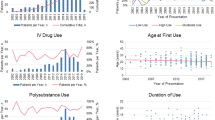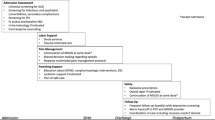Abstract
A 2012 committee opinion from the American College of Obstetricians and Gynecologists highlights the considerable increase in opioid addiction in recent years, yet little is known about clinical correlates of prescribed opioids among pregnant women. This study examines clinical and demographic factors associated with the use of opioid analgesics in pregnancy. Data were derived from a prospective cohort study of pregnant women. Participants were administered the Composite International Diagnostic Interview to identify depressive and anxiety disorders and data on medication use were gathered at three assessment points and classified according to the Anatomical Therapeutic Chemical Code (ATC) classification system ATC group N02A. Participants included 2,748 English or Spanish speaking pregnant women. Six percent (n = 165) of women used opioid analgesics at any point in pregnancy. More pregnant women using opioids met diagnostic criteria for major depressive disorder (16 vs. 8 % for non users), generalized anxiety disorder (18 vs. 9 % for non users), post-traumatic stress disorder (11 vs. 4 % for non users) and panic disorder (6 vs. 4 % for non users). Women who reported opioid use were also significantly more likely than non users to report using illicit drugs and almost three times as likely to report smoking cigarettes in the second or third trimester of pregnancy (4 and 23 %, respectively) as compared to non-opioid users (0.5 and 8 %). The use of opioids in pregnancy was associated with higher levels of psychiatric comorbidity and use of other substances as compared to non-opioid users.

Similar content being viewed by others
References
National Center on Addiction and Substance Use. (2006). Controlled prescription drug abuse at epidemic level. Journal of Pain and Palliative Care Pharmacotherapy, 20, 61–64.
Becker, W., Sullivan, L., Tetrault, J., Desai, R., & Fiellin, D. (2008). Non-medical use, abuse and dependence on prescription opioids among U.S. adults: Psychiatric, medical and substance use correlates. Drug and Alcohol Dependence, 94(1–3), 38–47.
Compton, W., & Volkow, N. (2006). Major increases in opioid analgesic abuse in the United States: concerns and strategies. Drug and Alcohol Dependence, 81, 103–107.
Compton, W., & Volkow, N. (2006). Abuse of prescription drugs and the risk of addiction. Drug and Alcohol Dependence, 83S, S4–S7.
Kuehn, B. (2007). Opioid prescriptions soar: Increase in legitimate use as well as abuse. JAMA, 297(3), 249–251.
Blanco, C., Alderson, D., Ogburn, E., Grant, B. F., Nunes, E. V., Hatzenbuehler, M. L., et al. (2007). Changes in the prevalence of non-medical prescription drug use and drug use disorders in the United States: 1991–1992 and 2001–2002. Drug and Alcohol Dependence, 90(2–3), 252.
SAMHSA SAaMHSA. (2007). Results from the 2007 National Survey on Drug Use and Health: National findings (pp. 1–290). Rockville, MD: Office of Applied Studies..
Manchikanti, L., & Singh, A. (2008). Therapeutic opioids: A ten-year perspective on the complexities and complications of the escalating use, abuse, and nonmedical use of opioids. Pain Physician, 9(4), 287–321: (11: S63–S88).
Hall, A., Logan, J., Toblin, R., Kaplan, J., Kraner, J., & Bixler, D. (2008). Patterns of abuse among unintentional pharmaceutical overdose fatalities. JAMA, 300(22), 2613–2620.
Bateman, B., Hernandez-Diaz, S., Rathmell, J., Seeger, J., Doherty, M., Fischer, M., et al. (2014). Patterns of opioid utilization in pregnancy in a large cohort of commercial insurance beneficiaries in the United States. Anesthesiology (on line first).
Andrade, S., Gurtwitz, J., & Davis, R. (2004). Prescription drug use in pregnancy. American Journal of Obstetrics and Gynecology, 191, 398–407.
Mitchell, A., Gilboa, S., Werler, M., Kelley, K., Louik, C., & Hernandez-Diaz, S. (2011). National Birth Defects Prevention Study: Medication use during pregnancy, with particular focus on prescription drugs: 1976–2008. American Journal of Obstetrics and Gynecology, 205(51), e1–e8.
Reynolds, E., Riel-Romero, R., & Bada H. (2007). Neonatal abstinence syndrome and cerebral infarction following maternal codeine use during pregnancy. Clinical pediatrics, 46, 639–645.
Jones, H. E., Kaltenbach, K., Heil, S. H., Stine, S. M., Coyle, M. G., Arria, A. M., et al. (2010). Neonatal abstinence syndrome after methadone or buprenorphine exposure. New England Journal of Medicine, 363(24), 2320–2331.
Finnegan, L. P. (1991). Treatment issues for opioid-dependent women during the perinatal period. Journal of Psychoactive Drugs, 23(2), 191–201.
Creanga, A. A. (2012). maternal drug use and its effect on neonates: A population-based study in Washington State. Obstetrics and Gynecology, 119(5), 924.
Minnes, S. (2011). Prenatal tobacco, marijuana, stimulant, and opiate exposure: Outcomes and practice implications. Addiction science & clinical practice, 6(1), 57.
Quesada, O., Gotman, N., Howell, H. B., Funai, E. F., Rounsaville, B. J., & Yonkers, K. A. (2012). Prenatal hazardous substance use and adverse birth outcomes. The Journal Of Maternal-Fetal & Neonatal Medicine: The Official Journal Of The European Association of Perinatal Medicine, the Federation of Asia and Oceania Perinatal Societies, the International Society of Perinatal Obstet, 25(8), 1222–1227.
Stanhope, T., Gill, L., & Rose, C. (2013). Chronic opioid use during pregnancy: Maternal and fetal implications. Clinics in Perinatology, 40, 337–350.
Wu, L., Woody, G., Yang, C., & Blazer, D. (2010). Subtypes of nonmedical opioid users: Results from the national epidemiologic survey on alcohol and related conditions. Drug and Alcohol Dependence, 112, 69–80.
Cicero, T., Lynskey, M., Todorov, A., Inciardi, J., & Surratt, H. (2008). Co-morbid pain and psychopathology in males and females admitted to treatment for opioid and analgesic abuse. Pain, 39, 127–135.
Back, S., Payne, R., Simpson, A., & Brady, K. (2010). Gender and prescription opioids: Findings from the National Survey on Drug Use and Health. Addictive Behaviors, 35, 1001–1007.
Handal, M., Engeland, A., Ronning, M., Skurtveit, S., & Furu, K. (2011). Use of prescribed opiod analgesics and co-medication with bensodiazepines in women before, during, and after pregnancy: a population-based cohort study. European Journal of Clinical Pharmacology, 67, 953–960.
Yonkers, K. A., Norwitz, E. R., Smith, M. V., Lockwood, C. J., Gotman, N., Luchansky, E., et al. (2012). Depression and serotonin reuptake inhibitor treatment as risk factors for preterm birth. Epidemiology, 23(5), 677–685.
Kessler, R., & Üstün, T. B. (2004). The World Mental Health (WMH) Survey Initiative Version of the World Health Organization (WHO) Composite International Diagnostic Interview (CIDI). The International Journal of Methods in Psychiatric Research, 13(2), 93–121.
Falsetti, S., Resnick, H., Pesick, P., & Kilpatrick, D. (1993). The modified PTSD symptom scale: A brief self-report measure of posttraumatic stress disorder. Behavior Therapist, 16, 161–162.
WHO. (2010). Collaborating center for drug statistics methodology. ATC Classification Index with DDDs.
Tuten, M., Heil, S. H., O’Grady, K. E., Fitzsimons, H., Chisolm, M. S., & Jones, H. E. (2009). The impact of mood disorders on the delivery and neonatal outcomes of methadone-maintained pregnant patients. [Erratum appears in Am J Drug Alcohol Abuse. 2010 Sep; 36(5):304]. American Journal of Drug and Alcohol Abuse, 35(5), 358–363.
Lund, I., Skurtveit, S., Sarfi, M., Bakstad, B., Welle-Strand, G., & Ravndal, E. (2011). A two-year prospective study of psychological distress among a national cohort of pregnant women in opioid maintenance treatment and their partners. Journal of Subst Use, 10, 639–645.
Lund, I. O., Skurtveit, S., Engeland, A., Furu, K., Ravndal, E., & Handal, M. (2013). Prescription drug use among pregnant women in opioid maintenance treatment. Addiction, 108(2), 367–376.
Daw, J. R., Hanley, G. E., Greyson, D. L., & Morgan, S. G. (2011). Prescription drug use during pregnancy in developed countries: A systematic review. Pharmacoepidemiology and Drug Safety, 20(9), 895–902.
Donati, S., Baglio, G., Spinelli, A., & Grandolfo, M. E. (2000). Drug use in pregnancy among Italian women. European Journal of Clinical Pharmacology, 56(4), 323–328.
Headley, J., Northstone, K., Simmons, H., Golding, J., & Team, A. S. (2004). Medication use during pregnancy: Data from the Avon Longitudinal Study of Parents and Children. European Journal of Clinical Pharmacology, 60(5), 355–361.
Colvin, L., Slack-Smith, L., Stanley, F. J., & Bower, C. (2009). Pharmacovigilance in pregnancy using population-based linked datasets. Pharmacoepidemiology and Drug Safety, 18(3), 211–225.
Gagne, J., Maio, V., Berghella, V., Louis, D., & Gonnella, J. (2008). Prescription drug use during pregnancy: A population-based study in Regione Emilia-Romagna, Italy. European Journal of Clinical Pharmacology, 64(11), 1125–1132.
Lacroix, I., Hurault, C., Sarramon, M. F., Guitard, C., Berrebi, A., Grau, M., et al. (2009). Prescription of drugs during pregnancy: A study using EFEMERIS, the new French database. European Journal of Clinical Pharmacology, 65(8), 839–846.
Riley, E., Fuentes-Afflick, E., & Jackson, R. (2005). Correlated of prescription drug use during pregnancy. Journal of Womens Health, 14, 401–409.
Broussard, C. S., Rasmussen, S. A., Reefhuis, J., Friedman, J. M., Jann, M. W., Riehle-Colarusso, T., et al. (2011). Maternal treatment with opioid analgesics and risk for birth defects. American journal of obstetrics and gynecology, 204(4), 314.e1–314.e11.
Nezvalova-Henriksen, K., Spigset, O., & Nordeng, H. (2011). Effects of codeine on pregnancy outcome: Results from a large population-based cohort study. European Journal of Clinical Pharmacology, 67(12), 1253–1261.
Martin, S., Keyes, K., Storr, C., Zhu, H., & Chilcoat, H. (2009). Pathways between nonmedical opioid use/dependence and psychiatric disorders: Results from the National Epidemiologic Survey on alcohol and related conditions. Drug and Alcohol Dependence, 103, 16–24.
Schepis, T., & Hakes, J. (2011). Non-medical prescription use increases the risk for the onset and recurrence of psychopathology: Results from the National Epidemiological Survey on Alcohol and Related Conditions. Addiction, 106, 2146–2155.
Grote, N. K., Bridge, J. A., Gavin, A. R., Melville, J. L., Iyengar, S., & Katon, W. J. (2010). A meta-analysis of depression during pregnancy and the risk of preterm birth, low birth weight, and intrauterine growth restriction. Archives of General Psychiatry, 67(10), 1012–1024.
Wisner, K., Sit, D., Hanusa, B., Moses-Kolko, E., Bogen, D., Hunker, D., et al. (2009). Major Depression and Antidepressant Treatment: Impact on Pregnancy and Neonatal Outcomes. American Journal of Psychiatry, 166, 557–566.
Sarangarm, P., Young, B., Rayburn, W., Jaiswal, P., Dodd, M., Phelan, S., et al. (2012). Agreement between self-report and prescription data in medical records for pregnant women. Birth Defects Research (Part A), 94, 153–161.
McCabe, S., Boyd, C., & Teter, C. (2009). Subtypes of nonmedical prescription drug misuse. Drug and Alcohol Dependence, 102, 63–70.
Barrett, S., Meisner, J., & Stewart, S. (2008). What constitutes prescription drug misuse? Problems and pitfalls of current conceptualizations. Current Drug Abuse Reviews, 1, 255–262.
Catalono, R., White, H., Fleming, C., & Haggery, K. (2011). Is nonmedical prescription opiate use a unique form or illict drug use? Addictive Behaviors, 36, 79–86.
Winklbaur, B., Kopf, N., Ebner, N., Jung, E., Thau, K., & Fischer, G. (2008). Treating pregnant women dependent on opioids is not the same as treating pregnancy and opioid dependence: A knowledge synthesis for better treatment for women and neonates. Addiction, 103(9), 1429–1440.
American College of Obstetricians & Gynecologists. (2012). Opioid abuse, dependence, and addiction in pregnancy.
Jones, H. (2013). Treating opioid use disorders during pregnancy: Historical, current, and future directions. Substance Abuse, 34(2), 89–91.
Morgan, M., Cragan, J., Goldenberg, R., Rasmussen, S., & Schulkin, J. (2010). Management of prescription and nonprescription drug use during pregnancy. The Journal of Maternal-Fetal and Neonatal Medicine, 23(8), 813–819.
Jansson, L., & Velez, M. (2012). Neonatal abstinence syndrome. Current Opinion in Pediatrics, 24(2), 252–258.
Acknowledgments
K12 DA031050 (Smith) and R01 HD045735.
Conflict of interest
Dr. Yonkers has the following conflicts to disclose: she has received study medication from Pfizer for an NIMH trial and has received royalties from Up to Date. All other investigators do not have any conflicts of interest.
Author information
Authors and Affiliations
Corresponding author
Electronic supplementary material
Below is the link to the electronic supplementary material.
Rights and permissions
About this article
Cite this article
Smith, M.V., Costello, D. & Yonkers, K.A. Clinical Correlates of Prescription Opioid Analgesic Use in Pregnancy. Matern Child Health J 19, 548–556 (2015). https://doi.org/10.1007/s10995-014-1536-6
Published:
Issue Date:
DOI: https://doi.org/10.1007/s10995-014-1536-6




